Show Room by Henry & Co. Design in Collaboration with Lee Jofa's Manor House Collection at the Decoration & Design Building, New York
March 19, 2020 - Berry Campbell
Henry & Co. Design
Kravet | Lee Jofa
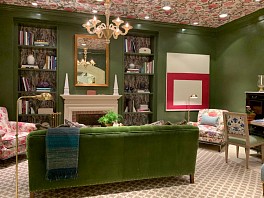
March 19, 2020 - Berry Campbell
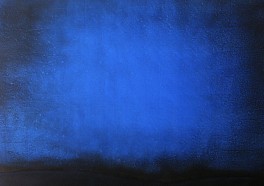
March 14, 2020
March 14 - July 5, 2020
Nassau County Museum of Art
Roslyn Harbor, New York
What color means more to us than blue? Even among the primaries, the color of the sky and sea commands a privileged place, by far the most popular hue in the spectrum according to surveys on every continent. Blue casts its spell, pushing beyond symbolism to a deeper emotional level, drawing us into its pure and distant mysteries. Every artist goes through a “blue period,” from the Mediterranean blues of Matisse and Yves Klein to the haunting auras of Redon. Blue has been holy to Egyptian, Hindu, Chinese and Western traditions. Its physical sources (cobalt, ultramarine, cerulean, indigo, lapis lazuli, cyan) are a catalogue of valued materials that rival gold itself. As this exhibition exuberantly proves, the power of blue transcends art history. Poets, filmmakers, musicians and designers have tapped its resonant appeal. The most original music in America (home of bluejeans, “democracy in fashion”) is the blues. We are turning the entire museum over to the multi-media exploration of blue in many incarnations. It spans history and geography, from the precious lapis lazuli of antiquity to paintings, photographs, sculpture, ceramics, cyanotypes, and fashion. As Miró said, “This is the color of my dreams.”
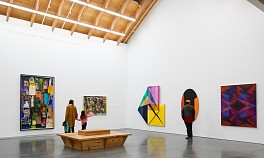
February 25, 2020 - Parrish Art Museum
Alicia Longwell on Women Artists in What We See, How We See
February 28, 6 pm - 7:30 pm
Alicia Longwell, the Lewis B. and Dorothy Cullman Chief Curator, Art and Education, highlights women artists in this seven-part exhibition that contextualizes the artists’ work through the lens of how they see and interpret the world around them.
VENUE
Parrish Art Museum
279 Montauk Highway, Water Mill, NY 11976 United States
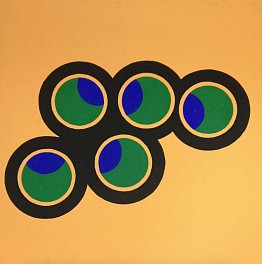
February 25, 2020 - Kim Uchiyama for Two Coats of Paint
Contributed by Kim Uchiyama / “Specific Forms” at Loretta Howard Gallery illuminates a particular moment in 20th century art history where works created by a variety of artists occupied the space between the then diverging ideologies of a young Donald Judd and those of the older critic Clement Greenberg. Saul Ostrow has curated a finely-tuned exhibit that demonstrates the highly individual modes of thought that were at play during this transitional time, ideas distinct from the critical positions of Minimalism, Pop and Color-field.
The movement known as Abstract Expressionism – a “movement” itself comprised of highly individualistic artists – can be seen in retrospect as the physical and psychological response to the global tensions of World War II. Mary Gabriel, in Ninth Street Women, her invaluable contribution to understanding the full scope of this era, emphasizes the war – and the lead up to war – as the underpinning for the formation of a new American art which would reflect the exigencies of the moment. The works in “Specific Forms” came about because these times had changed. Post-war America lacked the angst of the 1940s and 1950s, and was increasingly replaced in the 1960s and 1970s by an art that sought to look to itself reflexively, on its own terms – the thing being the thing itself.
In an era characterized by an implicit questioning of authority and established norms, these fourteen artists sought to break the mold of existing “-isms” and are seemingly preoccupied in creating a new consciousness via their art. The resulting works are highly specific unto themselves and characterized by strikingly individualistic terms for their existence.
Read More >>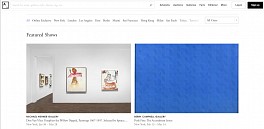
February 18, 2020 - Artsy
Perle Fine | The Accordment Series
February 13 - March 14, 2020
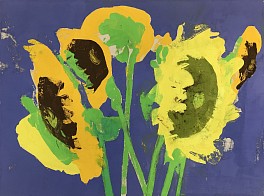
February 14, 2020 - TheaterBuffs
In this video, Eric Dever is interviewed by Patrick Christiano.
Read More >>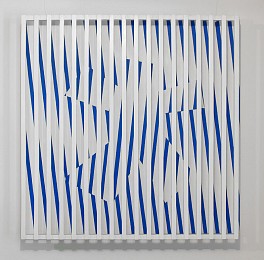
February 6, 2020 - D. Dominick Lombardi for Dart International Magazine
The success of an exhibition, or any work of art for that matter, is its ability to engage the viewer. Engagement can be a bit more difficult to achieve when you eliminate any sort of representation, as with the current exhibition at the Hofstra Museum of Art, Uncharted: American Abstraction in the Information Age. The fact that this show truly connects with the viewer – in this instance, partly through the use and influence of technology – illustrates the more thought provoking side of abstract art. Organized by Karen T. Albert, Acting Director and Chief Curator, with essays by Laurie Fendrich and Creighton Michael, Uncharted quickly draws you in through a variety of means that include everything from hi-tech contraptions to mesmerizing optics. When curiosity is piqued and perceptions are expanded, the viewer becomes part of the expression – a key difference between completely spelled out narrative representational art and non-representational abstraction. That unavoidable brain activity that is prompted by something new or visually foreign is very different than the comfort that straight representation brings.
...
The kinetic sculptures of James Seawright add a strong technological component to the exhibition. Using various sensors, Twins (1992) can be a bit sensitive to the movements in its immediate environment adding to its already palpable creepiness. Gemini (2004) and Lyra (2006) movements and lights are completely preprogrammed. As objects, they give the impression of designs for futuristic theater or movie sets. Despite the fact that all these works are between 14 and 28 years old, they maintain their immediacy and freshness. Like Lynne Harlow’s All Above the Moon, John Goodyear offers another aspect of physical participation for the viewer. By carefully swaying the picket fence-like apparatus in front of his two paintings, the art immediately becomes animated with short bursts of movement. Figurative Abstraction (2015) has an almost hypnotic effect on the viewer when it is activated – something like fabric billowing in the wind. The result with Diving Board (1983) is quite different. It shows a person’s feet continually being propelled by a very springy board, while offering much needed humor to the omnipresence of more elusive technology.
Read More >>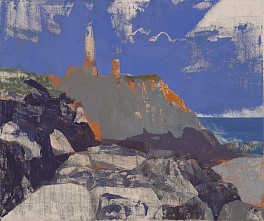
February 5, 2020 - Michelle Trauring for 27East
“If you have a minute, can I read you a poem quickly?”
With ample encouragement, artist Eric Dever clears his throat and begins. “Forever – is composed of Nows – / ‘Tis not a different time,” he recites. “Except for Infiniteness – / And Latitude of Home.”
He continues, the last two verses of the celebrated Emily Dickinson poem haunting as ever as they teach a crucial lesson: Every moment that has ever existed was, is or will be a present moment, a “now,” and the infinite is composed of them.
And forever stops for no one. It is with Dickinson’s words in mind that, last year, Dever began a new series of work. Each painting would be inspired by sequential lines of “Forever – Is Composed of Nows –,” the next canvas evolving from the previous.
And not long after he started, Dever cast the idea aside, out of sheer frustration — until recently. “Not too long ago, I realized the way to approach it is not to try to illustrate the poem, but to just select certain paintings and put them together, and that could very much hold the idea,” he said. “For me, I think an artist’s entire oeuvre, if we look at it, it really is a collection of ‘nows,’ and it’s not just ‘nows’ that are in the past. When I engage with my work over time, it’s almost as if that time or that place was in crystal. It’s very clear, the whole thing.”
Dever’s newest body of work, “A Thousand Nows” — on view at The Lyceum Gallery on Suffolk County Community College’s Eastern Campus in Riverhead — is a study in compressed time, the 22 exuberant oils layered with colors that span the artist’s lifetime, from his earliest memories growing up in California.
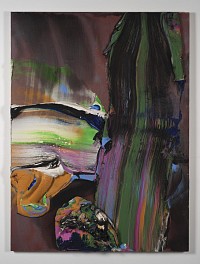
February 4, 2020 - Cori Hutchinson for Whitehot Magazine
Not necessarily spiked, each painting by New York artist James (familiarly Jim) Walsh instead crests like an eggy spire of Pavlova meringue; is viewed head-on as the subtle terrain of a human face. Painted on canvas then mounted, the pure paint impressively lifts off without the assistance of plaster or other molding material. Walsh’s work is distinct from other Modernist abstraction by its textural quality. His life-long professional experience with Golden Paints has rendered him an expert technician and master of patience. The paintings on view at Berry Campbell forego major scale in favor of a very concentrated surface, apprehending the viewer’s eye from an intimate distance. The show’s title "The Elemental," might allude to Robert Rauschenberg’s Elemental Paintings, which gave agency to both the vibrant life and eventual degradation of materials used, or feel back further to Renaissance elemental conception. Questions of alchemy, preservation, handling, and drying time are all brought to light by the reliefs of Walsh.
The compositions themselves range from tufted and pouty to petri dish to epic mixing bowl. There are obvious clusters of like-minded pieces, sharing color or arrangement. For example, BLEND, NATURAL, and MAGENTA MAJOR are unified by a lippy palette and quenelle bulge. CRIN CRIN and Untitled both utilize a radioactive green, smeared and smattered, respectively. On one wall, a pod of miniatures express continuity with crinkly white-on-black contrast, blue wash, and confetti drippage.
Pieces like SAND SOUND align themselves in the lineage of Color Field painter Jules Olitski. SAND SOUND, as well as POSITIVE VENUS, resemble slick sea glass. These pieces recall Olitski’s Plexiglas, 1986 show at KASMIN, particularly Dream Time (1986). Olitski’s hovering color—manifested by the illusion of the depth of glass—is taken up materially by Walsh. SAND SOUND, largely gray and green, achieves a texture that is at once sludge and mist, appearing wet almost.
Read More >>